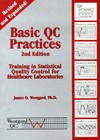Basic QC Practices
DO's and DON'Ts of Quality Control
Dr. Westgard makes it simple and gives a primer on how to avoid excessive repeat runs, inspection failures, and maybe even larger problems. (Preview)
What not to do?
- Don't use 2SD control limits
- Don't just repeat the controls
- Don't use the same control rules for all tests
- Don't use bottle values to calculate control limits
- Don't use medical decision limits as control limits
- Don't rely on electronic QC alone
- Don't eliminate SQC in POC applications
What to do?
- Do define the quality required for the test
- Do select QC procedures that minimize false rejections
- Do select QC procedures that detect medically important errors
- Do adopt modern QC planning tools and techniques
- Do standardize QC operations
- Do calculate control limits from your own laboratory data
- Do provide computer support to analyze and interpret QC data
- Do reject out-of-control runs, identify the problem, and eliminate the cause
- Do adopt a Total QC strategy to maximize the cost-effectiveness of QC
Is better QC technology needed?
References
Are improvements in quality control (QC) still needed? Do we need more sophisticated QC software? Do we need a more automated QC process? In short, do we need better QC technology in future laboratory systems?
These questions are being asked by many manufacturers as they design their next generation analytical systems. The usual setting for this discussion is a customer focus group, where a small group of key customers are involved with a carefully structured presentation and a carefully moderated discussion. The difficulty is that these questions about quality require a technical analysis, not a market analysis. In truth, most customers would prefer not to run QC at all since it costs time and effort and requires skills and training.
Quality is like safety - an important issue, but not a readily marketable feature. Witness safety in automobiles, where government regulations have driven progress, not customer market demand. Consider safety in the workplace, where government regulations are required to protect workers from hazards and danger. Consider safety in the home, where building codes set the standards for materials and smoke alarms. The market survey approach leads manufacturers to believe that improved quality systems aren't needed because customers don't demand these improvements. While customers may be aware of some of the current limitations, they don't know what might be possible in future technology. Manufacturers actually need to lead the market, rather than wait for customers to express those needs or have regulators impose new rules.
To provide a better perspective on the need for improvements in QC, let's consider what should be done to optimize QC practices. We'll start with a list of bad practices that need to be eliminated, then consider what to do to make improvements.
What NOT to do?
DON'T use 2 SD control limits!
Probably well over half of laboratories worldwide use control limits that are calculated as the mean plus and minus 2 standard deviations (SD), also known as a 12s rule. This practice is known to have a high level of false rejections - 1 out of every 20 points is expected to exceed 2SD limits, which is a 5% rate of false rejections. However, many laboratorians don't understand that when two controls are analyzed per run, the false rejections rate is 10%, with three control per run it's up to 14%, and with four controls per run it's about 18% [1]. This false rejection rate can potentially cause a 10 to 20% waste of laboratory resources! Certainly the use of 2SD control limits should be avoided with any automated analytical system. However, since customers aren't demanding such a change, manufacturers continue to support the use of 2SD limits in their QC software. Marketing responds to customer "wants", rather than the real "needs" for better QC procedures with lower false rejection rates. Wants and needs are not necessarily the same!
DON'T just repeat the controls!
In many laboratories, the common response to an out-of-control situation is just to repeat the controls, rather than to fix the problem [2]. The rationale is that the out-of-control situation is likely a false rejection, therefore, let's check again. And often if the repeats are still out, the response is to prepare new controls for analysis. And, of course, if they're out, they will also be repeated. The problem with this practice is that you're actually changing the control rules and are requiring that two or more consecutive points exceed a 2SD limit (e.g., 22s, 32s, even 42s). While this change in rules does reduce false rejections, it also reduces the error detection, leading to a practice that has little chance of detecting medically important errors.
DON'T use the same control rules for all tests!
If we need to eliminate 2SD control limits, should we use 3SD limits or possibly multirule QC instead? First of all, there's no one rule or one set of rules that's right for all tests and methods. Some methods have better precision than others, therefore different QC procedures should be used. The most cost-effective operation is possible when the QC procedures are selected for the individual tests on the basis of the quality required for the test and the performance observed for the method [1].
 We invite you to read the rest of this article
We invite you to read the rest of this article
To read a complete, updated version of this article, we invite you to purchase the Basic QC Practices manual, Second edition, or join the Basic QC Practices online course.
